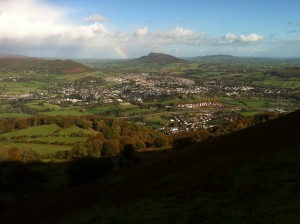Wednesday June 10th: I presented a series of eight workshops at St Thomas Cantilupe School in Hereford. Eight Babbulary workshops, one after another. It was a challenge, and one that I accepted in order to determine whether the core content of the workshop could extend across the primary age range. The answer is that, with a few tweaks, it can. The nursery pupils laughed at the silly sound effects and slapstick mime, but bobbed about to the rhythm and syllable sequences and were genuinely very nice to me. Meanwhile, at the other end of the age range, the Year 6 pupils were almost as keen to submit to the nonsense, and once they realised this was a joint exploration, were quite gleeful. They were happy to launch the Pencil of Destiny into the Balloon of Nastybad, and restore peace. They seemed fascinated by the presentation I gave on my favourite words – for example, the word turkey (the animal) is dinde (of India) in French, and simply peru in Portuguese. Perhaps the pupils in the middle, the seven and eight year olds, were the most reluctant to accept the lunacy of the enterprise, one child declaring, right at the end of the day ‘what was that all about?’ A question I took as the highest compliment. I’ve always thought experience is the best means of learning anything, (how do we learn to talk?) so I want the workshops to be sensory as well as conceptually challenging. I don’t tell the children what it is they are going to learn because each will take away something different, or, in the case of the child who asked the question at the end, go away wondering what it was all about.
There was one major flaw in the proceedings, however, and that was my tendency, later in the day, to confuse one workshop with the next (they were in thirty minute slots, one after another) so I often forgot to include something because, mistakenly, I thought we’d just done it. (Not realising it was covered in the previous workshop!) It got very hairy towards the last two sessions, when my head was beginning to spin, and the children (having spent the day in other workshops) were spinning too.
But a hugely positive experience, and wonderful, lively, interesting children.
